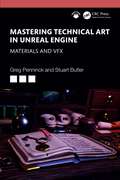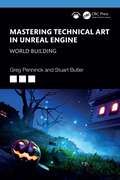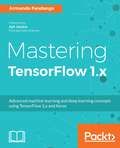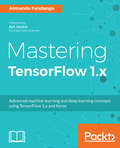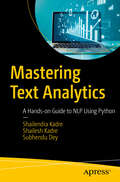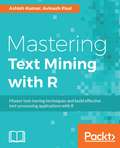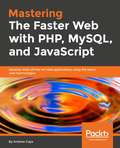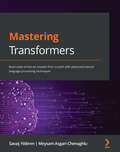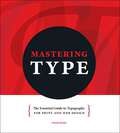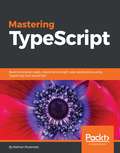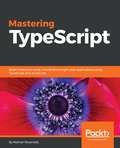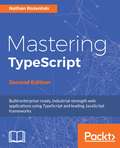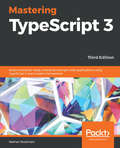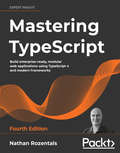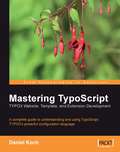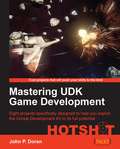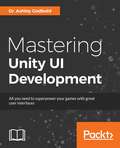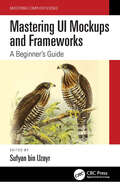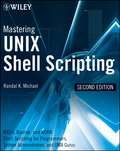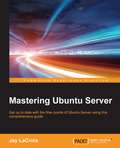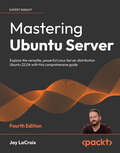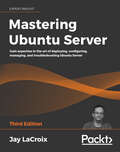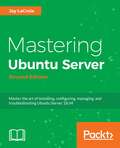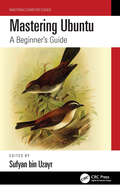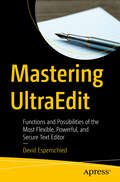- Table View
- List View
Mastering Technical Art in Unreal Engine: Materials and VFX
by Greg Penninck Stuart ButlerThis book covers how to build materials and VFX that bring your projects to life in Unreal Engine. Each chapter will provide you with the necessary underpinning theory as well as activities to test your learning inside of Unreal Engine.You'll learn about Material Graphs, Parameters, Instances, Materials Maths, Nodes, Niagara Emitters and much more as you complete project-based examples. Included in the book is a series of introductory demonstration videos and quizzes to help test your learning, giving you all the tools and knowledge to make cutting-edge game materials and VFX.This book will be of great interest to all students learning to create technical art within Unreal Engine, as well as professionals looking to sharpen their skills.
Mastering Technical Art in Unreal Engine: World Building
by Stuart Butler Greg PenninckThis covers how to use the latest development tools to create your own Virtual World powered by Unreal Engine. Each chapter will provide you with the necessary underpinning theory as well as activities to test your learning inside of Unreal Engine.You'll learn about Landscapes, Sculpting, Materials, Foliage, Water, Partitions and much more as you complete project-based examples. Included in the book is a series of follow-along introductory videos and quizzes to help test your learning, giving you all the tools and knowledge to make detailed believable worlds in the Unreal Engine.This book will be of great interest to all students learning to create technical art within Unreal Engine, as well as professionals looking to sharpen their skills.
Mastering TensorFlow 1.x: Advanced Machine Learning And Deep Learning Concepts Using Tensorflow 1. X And Keras
by Armando FandangoWe cover advanced deep learning concepts (such as transfer learning, generative adversarial models, and reinforcement learning), and implement them using TensorFlow and Keras. We cover how to build and deploy at scale with distributed models. You will learn to build TensorFlow models using R, Keras, TensorFlow Learn, TensorFlow Slim and Sonnet
Mastering TensorFlow 1.x: Advanced machine learning and deep learning concepts using TensorFlow 1.x and Keras
by Armando Fandango Nick McClureBuild, scale, and deploy deep neural network models using the star libraries in Python Key Features Delve into advanced machine learning and deep learning use cases using Tensorflow and Keras Build, deploy, and scale end-to-end deep neural network models in a production environment Learn to deploy TensorFlow on mobile, and distributed TensorFlow on GPU, Clusters, and Kubernetes Book Description TensorFlow is the most popular numerical computation library built from the ground up for distributed, cloud, and mobile environments. TensorFlow represents the data as tensors and the computation as graphs. This book is a comprehensive guide that lets you explore the advanced features of TensorFlow 1.x. Gain insight into TensorFlow Core, Keras, TF Estimators, TFLearn, TF Slim, Pretty Tensor, and Sonnet. Leverage the power of TensorFlow and Keras to build deep learning models, using concepts such as transfer learning, generative adversarial networks, and deep reinforcement learning. Throughout the book, you will obtain hands-on experience with varied datasets, such as MNIST, CIFAR-10, PTB, text8, and COCO-Images. You will learn the advanced features of TensorFlow1.x, such as distributed TensorFlow with TF Clusters, deploy production models with TensorFlow Serving, and build and deploy TensorFlow models for mobile and embedded devices on Android and iOS platforms. You will see how to call TensorFlow and Keras API within the R statistical software, and learn the required techniques for debugging when the TensorFlow API-based code does not work as expected. The book helps you obtain in-depth knowledge of TensorFlow, making you the go-to person for solving artificial intelligence problems. By the end of this guide, you will have mastered the offerings of TensorFlow and Keras, and gained the skills you need to build smarter, faster, and efficient machine learning and deep learning systems. What you will learn Master advanced concepts of deep learning such as transfer learning, reinforcement learning, generative models and more, using TensorFlow and Keras Perform supervised (classification and regression) and unsupervised (clustering) learning to solve machine learning tasks Build end-to-end deep learning (CNN, RNN, and Autoencoders) models with TensorFlow Scale and deploy production models with distributed and high-performance computing on GPU and clusters Build TensorFlow models to work with multilayer perceptrons using Keras, TFLearn, and R Learn the functionalities of smart apps by building and deploying TensorFlow models on iOS and Android devices Supercharge TensorFlow with distributed training and deployment on Kubernetes and TensorFlow Clusters Who this book is for This book is for data scientists, machine learning engineers, artificial intelligence engineers, and for all TensorFlow users who wish to upgrade their TensorFlow knowledge and work on various machine learning and deep learning problems. If you are looking for an easy-to-follow guide that underlines the intricacies and complex use cases of machine learning, you will find this book extremely useful. Some basic understanding of TensorFlow is required to get the most out of the book.
Mastering Text Analytics: A Hands-on Guide to NLP Using Python
by Shailendra Kadre Shailesh Kadre Subhendu DeyThis book is a comprehensive guide to mastering Natural Language Processing (NLP), a rapidly growing field in AI-powered text and data analytics. It equips you with tools and techniques to extract valuable insights from both structured and unstructured data, enabling you to uncover insights beyond the reach of traditional data analysis methods and stay competitive in this evolving domain. The book starts with foundational concepts, such as collecting and extracting data for NLP projects, before progressing to advanced topics like applications of transfer learning in NLP and Large Language Models (LLMs). Each chapter emphasizes real-world applications and includes practical case studies to ensure the knowledge is immediately applicable. Throughout the book, readers will find Python code demonstrations, hands-on projects, and detailed explanations of key concepts. Special features include business use cases from industries like healthcare and customer service, practice exercises to reinforce learning, and explorations of emerging NLP technologies. These elements make the book not only informative but also highly engaging and interactive. By the end of the book, the reader will have a solid foundation in Generative AI techniques to apply them to complex challenges. Whether you&’re a budding data scientist or a seasoned professional, this guide will help you harness the power of AI-driven text and data analytics effectively. What you will learn: Understand NLP with easy-to-follow explanations, examples, and Python implementations. Explore techniques such as transformers, word embeddings, and pragmatic analysis in real-world contexts. Work with real-world datasets and apply pre-processing, tokenization, and text extraction using NLP libraries. How to build complete NLP pipelines from data collection to model implementation, including sentiment analysis and chatbots. Learn state-of-the-art methods like deep learning techniques in NLP, large language models (LLMs), and zero-shot learning in NLP. Who this book is for: This book is tailored for data scientists, machine learning engineers, AI practitioners, and software developers seeking to learn NLP techniques and apply them to solve problems.
Mastering Text Mining with R
by Ashish Kumar Avinash PaulMaster text-taming techniques and build effective text-processing applications with R About This Book • Develop all the relevant skills for building text-mining apps with R with this easy-to-follow guide • Gain in-depth understanding of the text mining process with lucid implementation in the R language • Example-rich guide that lets you gain high-quality information from text data Who This Book Is For If you are an R programmer, analyst, or data scientist who wants to gain experience in performing text data mining and analytics with R, then this book is for you. Exposure to working with statistical methods and language processing would be helpful. What You Will Learn • Get acquainted with some of the highly efficient R packages such as OpenNLP and RWeka to perform various steps in the text mining process • Access and manipulate data from different sources such as JSON and HTTP • Process text using regular expressions • Get to know the different approaches of tagging texts, such as POS tagging, to get started with text analysis • Explore different dimensionality reduction techniques, such as Principal Component Analysis (PCA), and understand its implementation in R • Discover the underlying themes or topics that are present in an unstructured collection of documents, using common topic models such as Latent Dirichlet Allocation (LDA) • Build a baseline sentence completing application • Perform entity extraction and named entity recognition using R In Detail Text Mining (or text data mining or text analytics) is the process of extracting useful and high-quality information from text by devising patterns and trends. R provides an extensive ecosystem to mine text through its many frameworks and packages. Starting with basic information about the statistics concepts used in text mining, this book will teach you how to access, cleanse, and process text using the R language and will equip you with the tools and the associated knowledge about different tagging, chunking, and entailment approaches and their usage in natural language processing. Moving on, this book will teach you different dimensionality reduction techniques and their implementation in R. Next, we will cover pattern recognition in text data utilizing classification mechanisms, perform entity recognition, and develop an ontology learning framework. By the end of the book, you will develop a practical application from the concepts learned, and will understand how text mining can be leveraged to analyze the massively available data on social media. Style and approach This book takes a hands-on, example-driven approach to the text mining process with lucid implementation in R.
Mastering The Faster Web with PHP, MySQL, and JavaScript: Develop state-of-the-art web applications using the latest web technologies
by Andrew CayaMake web applications run faster by using advanced PHP, SQL and JavaScript techniquesKey FeaturesUse a customized PHP stack to create efficient data-driven web applicationsEnsure seamless implementation of a JavaScript & HTML 5 CSS based frontend and PHP based backend. Learn about problem identification, best strategies, and UI design patterns as well to build a clean, fast web applicationBook DescriptionThis book will get you started with the latest benchmarking, profiling and monitoring tools for PHP, MySQL and JavaScript using Docker-based technologies. From optimizing PHP 7 code to learning asynchronous programming, from implementing Modern SQL solutions to discovering Functional JavaScript techniques, this book covers all the latest developments in Faster Web technologies. You will not only learn to determine the best optimization strategies, but also how to implement them.Along the way, you will learn how to profile your PHP scripts with Blackfire.io, monitor your Web applications, measure database performance, optimize SQL queries, explore Functional JavaScript, boost Web server performance in general and optimize applications when there is nothing left to optimize by going beyond performance.After reading this book, you will know how to boost the performance of any Web application and make it part of what has come to be known as the Faster Web.What you will learnInstall, confgure, and use profling and benchmarking testing toolsUnderstand how to recognize optimizable data structures and functions to effectively optimize a PHP7 applicationDiagnose bad SQL query performance and discover ways to optimize itGrasp modern SQL techniques to optimize complex SQL queriesIdentify and simplify overly complex JavaScript codeExplore and implement UI design principles that effectively enhance the performanceCombine web technologies to boost web server performanceWho this book is forThe audience for this book would be PHP developers who have some basic knowledge of PHP programming and Web technologies. JavaScript programming knowledge is not necessary.
Mastering Transformers: Build state-of-the-art models from scratch with advanced natural language processing techniques
by Savas Yildirim Meysam Asgari-ChenaghluTake a problem-solving approach to learning all about transformers and get up and running in no time by implementing methodologies that will build the future of NLPKey FeaturesExplore quick prototyping with up-to-date Python libraries to create effective solutions to industrial problemsSolve advanced NLP problems such as named-entity recognition, information extraction, language generation, and conversational AIMonitor your model's performance with the help of BertViz, exBERT, and TensorBoardBook DescriptionTransformer-based language models have dominated natural language processing (NLP) studies and have now become a new paradigm. With this book, you'll learn how to build various transformer-based NLP applications using the Python Transformers library. The book gives you an introduction to Transformers by showing you how to write your first hello-world program. You'll then learn how a tokenizer works and how to train your own tokenizer. As you advance, you'll explore the architecture of autoencoding models, such as BERT, and autoregressive models, such as GPT. You'll see how to train and fine-tune models for a variety of natural language understanding (NLU) and natural language generation (NLG) problems, including text classification, token classification, and text representation. This book also helps you to learn efficient models for challenging problems, such as long-context NLP tasks with limited computational capacity. You'll also work with multilingual and cross-lingual problems, optimize models by monitoring their performance, and discover how to deconstruct these models for interpretability and explainability. Finally, you'll be able to deploy your transformer models in a production environment. By the end of this NLP book, you'll have learned how to use Transformers to solve advanced NLP problems using advanced models.What you will learnExplore state-of-the-art NLP solutions with the Transformers libraryTrain a language model in any language with any transformer architectureFine-tune a pre-trained language model to perform several downstream tasksSelect the right framework for the training, evaluation, and production of an end-to-end solutionGet hands-on experience in using TensorBoard and Weights & BiasesVisualize the internal representation of transformer models for interpretabilityWho this book is forThis book is for deep learning researchers, hands-on NLP practitioners, as well as ML/NLP educators and students who want to start their journey with Transformers. Beginner-level machine learning knowledge and a good command of Python will help you get the best out of this book.
Mastering Type: The Essential Guide to Typography for Print and Web Design
by Denise BoslerGood Design, Down to the LetterPackages on store shelves, posters on building walls, pages of a website-all contain information that needs to be communicated. And at the heart of that communication is type: visually interesting, interactive, expressive and captivating. Each letter must come alive; therefore, each letter must be carefully crafted or chosen. A solid foundation in typography, as well as an understanding of its nuances, will help you optimize your visual communication-in whatever form it takes.By breaking down the study of type into a systematic progression of relationships-letter, word, sentence, paragraph, page and screen-award-winning graphic designer and professor of communication design Denise Bosler provides a unique and illuminating perspective on typography for both print and digital media and for designers of all skill levels.Through instruction, interviews and real-world inspiration, Mastering Type explores the power of each typographic element--both as it stands alone and as it works with other elements--to create successful design, to strengthen your skill set and to inspire your next project.
Mastering TypeScript
by Nathan RozentalsWhether you are a JavaScript developer aiming to learn TypeScript, or an experienced TypeScript developer wanting to take your skills to the next level, this book is for you. From basic to advanced language constructs, test-driven development, and object-oriented techniques, you will learn how to get the most out of the TypeScript language.
Mastering TypeScript
by Nathan Rozentals<P><P>Build enterprise-ready, industrial strength web applications using TypeScript and leading JavaScript frameworks <P><P>Key Features <P><P>Focus on test-driven development to help build quality applications that are modular, scalable, maintainable, and adaptable. <P><P>Practical examples that show you how to use TypeScript with popular JavaScript frameworks including Backbone, Angular, Node.js, require.js, and Marionette <P><P>Enhance your TypeScript knowledge with in-depth discussions on language features, third-party libraries, declaration files, and so on using practical scenarios. <P><P>Book Description <P><P>The TypeScript compiler and language has brought JavaScript development up to the enterprise level, yet still maintains backward compatibility with existing JavaScript browsers and libraries. <P><P>Packed with practical code samples, this book brings the benefits of strongly typed, object-oriented programming and design principles into the JavaScript development space. Starting with core language features, and working through more advanced topics such as generics and modules, you will learn how to gain maximum benefit from your JavaScript development with TypeScript. With a strong focus on test-driven development and coverage of many popular JavaScript frameworks, you can fast-track your TypeScript knowledge to a professional level. By the end of this book, you will be able to confidently implement a TypeScript application from scratch. <P><P>What you will learn <P><P>Gain an insight into core and advanced TypeScript language features including inheritance and generics <P><P>Integrate your existing JavaScript code and third-party JavaScript libraries by writing and using declaration files <P><P>Write TypeScript code to target popular JavaScript frameworks such as jQuery, Backbone, Angular, Node, and Marionette <P><P>Create extensive testing suites for your application, including unit testing, integration testing, and browser automation with Jasmine and Selenium <P><P>Organize your application code using modules, and utilize Asynchronous Module Loading with require.js <P><P>Explore advanced object-oriented techniques including dependency injection and strongly typed domain events <P><P>Build a complete single-page web application with TypeScript and Marionette, incorporating object-oriented design patterns along the way <P><P>Who This Book Is For <P><P>Whether you are a JavaScript developer aiming to learn TypeScript, or an experienced TypeScript developer wanting to take your skills to the next level, this book is for you. From basic to advanced language constructs, test-driven development, and object-oriented techniques, you will learn how to get the most out of the TypeScript language.
Mastering TypeScript - Second Edition
by Nathan RozentalsWhether you are a JavaScript developer who wants to learn TypeScript or an experienced TypeScript developer who wants to take your skills to the next level, this book is for you. If you are an enterprise JavaScript developer who builds web sites using Backbone, Marionette, Angular, Angular 2, Aurelia, or React.js, then this book will make you a better, more productive programmer.
Mastering TypeScript 3 - Third Edition: Build enterprise-ready, industrial-strength web applications using TypeScript 3 and modern frameworks, 3rd Edition
by Nathan RozentalsThe book is for intermediate/experienced web developers with knowledge of JS and basics of JS who wants to delve into the advanced concepts of TypeScripts and build enterprise-ready web and desktop applications using the only TypeScript at the front and back end. Learn how to use TypeScript with a multitude of modern frameworks, and choose the best framework for your project requirements.
Mastering TypeScript: Build enterprise-ready, modular web applications using TypeScript 4 and modern frameworks, 4th Edition
by Nathan RozentalsMaster the TypeScript language and its latest features, explore modern web application frameworks, and build modular systems using industry standard architectural principles and design patterns.Key FeaturesExplore TypeScript 4's key elements and advanced language featuresUse TypeScript with modern frameworks such as Angular, Vue, React, RxJS and NodeUnderstand TDD, serverless techniques, micro frontends, and other industry-standard best practices to create high-quality and modular appsBook DescriptionTypeScript is both a language and a set of tools to generate JavaScript. It was designed by Anders Hejlsberg at Microsoft to help developers write enterprise-scale JavaScript. Using a fast-paced, but easy-to-follow set of code samples, this fourth edition will get you up and running with Typescript quickly, introduce core concepts, and then build on this knowledge to help you understand and then apply more advanced language features. Mastering TypeScript, Fourth Edition also covers a variety of modern JavaScript and TypeScript frameworks and compares their respective strengths and weaknesses. As you advance through this TypeScript book, you'll explore Angular, React, Vue, RxJs, Express, NodeJS, and others. You'll get up to speed with unit and integration testing, data transformation, serverless technologies, and asynchronous programming. You'll also learn how to integrate with existing JavaScript libraries, control your compiler options, and use decorators and generics. By the end of the book, you will have built a comprehensive set of web applications using Angular, React, and Vue, having integrated them into a single cohesive website, using micro front-end techniques. Mastering TypeScript, Fourth Edition is about learning the language, understanding when to apply its features, and then selecting the framework that is the perfect fit for your real-world project.What you will learnGain insights into core and advanced TypeScript language featuresIntegrate with existing JavaScript libraries and third-party frameworksBuild full working applications using JavaScript frameworks, such as Angular, React, Vue, and moreCreate test suites for your application with Jest and SeleniumApply industry-standard design patterns to build modular codeDevelop web server solutions using NodeJS and ExpressDesign and implement serverless API solutionsExplore micro front-end technologies and techniquesWho this book is forThis book serves as a guide for beginners, as well as providing practical insights and techniques for experienced JavaScript and TypeScript programmers. No prior knowledge of JavaScript is required.If you are keen to learn TypeScript, this book will give you all the necessary knowledge and skills to tackle any TypeScript project. It will also give you an understanding of what application frameworks are out there, and which one to choose for your next project. If you are already an experienced JavaScript or TypeScript developer, then this book will take your skills to the next level.
Mastering TypoScript: TYPO3 Website, Template, and Extension Development
by Daniel KochWritten in a clear, easy-to-read style, the book provides step-by-step instructions on using TypoScript for TYPO3 website development, template and extension development, and back-end and front-end administration. Each topic is tackled in a clear and practical way with many examples to develop your skills. This book is suitable for TYPO3 developers, administrators, and designers who want to develop fully featured TYPO3 websites using the power of TypoScript. A basic knowledge of TYPO3 is expected, and PHP and MySQL programming experience is useful, though not essential for using this book.
Mastering UDK Game Development
by John P. DoranWritten as a series of engaging and practical projects, this essential guide will help you take your skills to the next level and become a game development hotshot. If you would like to truly unlock the potential of the Unreal Development Kit or are interested in using Scaleform for your own personal projects, then this book is for you."Mastering UDK Game Development" was designed for people who want to truly take their projects to the next level. Those who are familiar with the basics of creating things in UDK will have an easier time, but each project contains step-by-step explanations, diagrams, screenshots, and downloadable content that should make it possible for someone with no prior experience to learn UDK at an accelerated pace.
Mastering UI Development with Unity: An in-depth guide to developing engaging user interfaces with Unity 5, Unity 2017, and Unity 2018
by Ashley GodboldMaster Game UI system by creating captivating user interface components with Unity 5 through Unity 2018 and C#. Learn about UI texts, images, world space UI, mobile-specific UI and much more.Key FeaturesDevelop a game UI with both technical and aesthetic considerationsUse all the UI elements provided by Unity's UI systemStep-by-step examples of creating user interface components in the top game genresBook DescriptionA functional UI is an important component for player interaction in every type of video game. Along with imparting crucial statistical information to the player, the UI is also the window through which the player engages with the world established by the game. Unity's tools give you the opportunity to create complex and attractive UIs to make your game stand out.This book helps you realize the full potential of Unity's powerful tools to create the best UI for your games by walking you through the creation of myriad user interface components. Learn how to create visually engaging heads-up-displays, pause menus, health bars, circular progress bars, animated menus, and more. This book not only teaches how to lay out visual elements, but also how to program these features and implement them across multiple games of varying genres.While working through the examples provided, you will learn how to develop a UI that scales to multiple screen resolutions, so your game can be released on multiple platforms with minimal changes. What you will learnDesign principles and patterns for laying out elements in your UITechniques that allow your UI to scale appropriately in different resolutionsHow to use automatic layouts to streamline your UI building processProperties of the Event System and how to appropriately hook events to your UI elementsAccess the components and properties of UI elements via code Implement all of Unity's built-in UI elements as well as those provided by TextMeshPro Develop key UI components that are popularly used in multiple game genresAdd visual flare to user interfaces with the use of animation and particle effectsCreate a UI that displays in the Screen Space as well as World SpaceWho this book is forThis book is for anyone keen to improve their games via a great user interface with Unity's UI system. If you're looking for a book that explains how to develop specific user interfaces or that thoroughly explains how each of the individual Unity components work, this book is for you.
Mastering UI Mockups and Frameworks: A Beginner's Guide (Mastering Computer Science)
by Sufyan Bin UzayrMastering UI Mockups and Frameworks: A Beginner's Guide sets the standard for studying wireframes, mockups, and different tools along with their unique features. This book comprehensively analyzes the design, portability, and efficiency of these tools. As a beginner’s guide, Mastering UI Mockups and Frameworks addresses various methods to use these types of tools. This book will help you shape your understanding of UI and UX tools regardless of your skill level. Wireframes and mockups are standard tools used during the design process. A mockup is a visual presentation of a website or an app. Designers always use mockups to highlight their website’s layout and functionality to their prospective clients. Choosing a particular tool at the right stage will help you ensure that the correct level of effort is invested so that you can deliver functionality that solves an actual customer requirement. Mastering UI Mockups and Frameworks helps you accomplish this! This book explores the design, compactness, and performance of different UX/UI tools by completing various comparative discussions. Mastering UI Mockups and Frameworks has an abundant supply of tested, functional, and documented Wireframe and mockup tools by providing comprehensive, practical, easy-to-grab solutions and paying close attention to both efficiency and portability. This book also discusses the latest updates added to the UX/UI tools. Furthermore, Mastering UI Mockups and Frameworks offers information for students and professionals interested in knowing more about such tools and their outstanding efficacies. While wireframes and prototypes are low-fidelity formats, mockups are more intuitive. They help clients visualize how the final product will look, feel, and work. Mockups also help remove ambiguity regarding the client’s expectations. Clients can detect gaps on the website by looking at its mockup and suggesting early product revisions. By using mockups for each iteration, designers can create a final product that meets client requirements. Wireframing is an unavoidable part of the design process. You will have a lot of ideas to brainstorm while working on a mobile app or website project. The Wireframing brainstorm sessions’ main purpose is to make them with minimal effort and to facilitate creativity. Whether or not you are a designer, wireframing is a necessary skill to have in your toolkit. It is conducive for marketers, product managers, or any person with ideas for a mobile app or website. It is an irreplaceable tool for visualizing user experiences, iterating ideas, and sharing ideas. It undoubtedly performs like a design blueprint. Wireframes stipulate a path for conceptual structuring out an application, whether structurally or visually. Mastering UI Mockups and Frameworks provides you with the uniqueness of two irreplaceable parts of the designing world: mockups and wireframes. This book covers different mockup and wireframe tools, including Adobe XD, Mockplus, Moqups, Mockplus iDOC, Sketch Figma, UXpin, and Axure RP, as well as their functionality and portability. Using some of these mockup tools, you can create interactive mockups that can be exported and run on any device working as a real application. This is a robust way to test your knowledge about your apps. It will also help with detailed instructions for developers, making their job easier and faster. If you are looking to get started with the world of UI and UX, Mastering UI Mockups and Frameworks is the book to read! Learn more about our other Mastering titles at: https://www.routledge.com/Mastering-Computer-Science/book-series/MCS
Mastering UNIX Shell Scripting Second Edition
by Randal K. MichaelUNIX expert Randal K. Michael guides you through every detail of writing shell scripts to automate specific tasks. Each chapter begins with a typical, everyday UNIX challenge, then shows you how to take basic syntax and turn it into a shell scripting solution. Covering Bash, Bourne, and Korn shell scripting, this updated edition provides complete shell scripts plus detailed descriptions of each part. UNIX programmers and system administrators can tailor these to build tools that monitor for specific system events and situations, building solid UNIX shell scripting skills to solve real-world system administration problems.
Mastering Ubuntu Server
by Jay LacroixGet up to date with the finer points of Ubuntu Server using this comprehensive guide About This Book * Get well-versed with newly-added features in Ubuntu 16.04 * Master the art of installing, managing, and troubleshooting Ubuntu Server * A practical easy-to-understand book that will help you enhance your existing skills. Who This Book Is For This book is intended for readers with intermediate or advanced-beginner skills with Linux, who would like to learn all about setting up servers with Ubuntu Server. This book assumes that the reader knows the basics of Linux, such as editing configuration files and running basic commands. What You Will Learn * Learn how to manage users, groups, and permissions * Encrypt and decrypt disks with Linux Unified Key Setup /Luks * Setup SSH for remote access, and connect it to other nodes * Understand how to add, remove, and search for packages * Use NFS and Samba to share directories with other users * Get to know techniques for managing Apache and MariaDB * Explore best practices and troubleshooting techniques In Detail Ubuntu is a Debian-based Linux operating system, and has various versions targeted at servers, desktops, phones, tablets and televisions. The Ubuntu Server Edition, also called Ubuntu Server, offers support for several common configurations, and also simplifies common Linux server deployment processes. With this book as their guide, readers will be able to configure and deploy Ubuntu Servers using Ubuntu Server 16.04, with all the skills necessary to manage real servers. The book begins with the concept of user management, group management, as well as file-system permissions. To manage your storage on Ubuntu Server systems, you will learn how to add and format storage and view disk usage. Later, you will also learn how to configure network interfaces, manage IP addresses, deploy Network Manager in order to connect to networks, and manage network interfaces. Furthermore, you will understand how to start and stop services so that you can manage running processes on Linux servers. The book will then demonstrate how to access and share files to or from Ubuntu Servers. You will learn how to create and manage databases using MariaDB and share web content with Apache. To virtualize hosts and applications, you will be shown how to set up KVM/Qemu and Docker and manage virtual machines with virt-manager. Lastly, you will explore best practices and troubleshooting techniques when working with Ubuntu Servers. By the end of the book, you will be an expert Ubuntu Server user well-versed in its advanced concepts. Style and Approach This book is an advanced guide that will show readers how to administer, manage, and deploy Ubuntu server and will also provide expert-level knowledge on advanced security and backup techniques.
Mastering Ubuntu Server: Explore the versatile, powerful Linux Server distribution Ubuntu 22.04 with this comprehensive guide, 4th Edition
by Jay LaCroixYour one-stop resource to learn, configure and use Ubuntu 22.04 for your day-to-day operations and deploymentsKey FeaturesGet well-versed with newly added features in Ubuntu 22.04Master the art of installing, managing, and troubleshooting Ubuntu ServerLeverage the improved performance and security-related aspects of Ubuntu Server 22.04Book DescriptionUbuntu Server is taking the server world by storm - and for a good reason! The server-focused spin of Ubuntu is a stable, flexible, and powerful enterprise-class distribution of Linux with a focus on running servers both small and large.Mastering Ubuntu Server is a book that will teach you everything you need to know in order to manage real Ubuntu-based servers in actual production deployments. This book will take you from initial installation to deploying production-ready solutions to empower your small office network, or even a full data center. You'll see examples of running an Ubuntu Server in the cloud, be walked through set up popular applications (such as Nextcloud), host your own websites, and deploy network resources such as DHCP, DNS, and others. You'll also see how to containerize applications via LXD to maximize efficiency and learn how to build Kubernetes clusters. This new fourth edition updates the popular book to cover Ubuntu 22.04 LTS, which takes advantage of the latest in Linux-based technologies.By the end of this Ubuntu book, you will have gained all the knowledge you need in order to work on real-life Ubuntu Server deployments and become an expert Ubuntu Server administrator who is well versed in its feature set.What you will learnInstall Ubuntu Server on physical servers and on the Raspberry PiDeploy Ubuntu Server in the cloud and host websites on your own serverDeploy your applications to their own containers and scale your infrastructureSet up popular applications such as NextcloudAutomate deployments and configuration with Ansible to save timeContainerize applications via LXD to maximize efficiencyDiscover best practices and troubleshooting techniquesWho this book is forThis book is for System Administrators, Site Reliability Engineers, DevOps professionals, enthusiasts, as well as for individuals looking to make a career change and learn the skills they'll need to work with Ubuntu servers. Prior knowledge of Ubuntu is not required but a basic understanding of basic computing concepts is assumed. Some IT administration, Linux, and shell scripting experience is preferred, although the first several chapters will bring newcomers up to speed as well.
Mastering Ubuntu Server: Gain expertise in the art of deploying, configuring, managing, and troubleshooting Ubuntu Server, 3rd Edition
by Jay LaCroixThis is the third edition of the bestselling one-stop resource for sysadmins and DevOps professionals to learn, configure and use Ubuntu 20.04 for their day-to-day operations and deployments.Key FeaturesA hands-on book that will teach you how to deploy, maintain and troubleshoot Ubuntu ServerLearn to leverage the improved performance and security-related aspects of Ubuntu Server 20.04 LTSNew chapters dedicated to exploring Ubuntu for cloudBook DescriptionUbuntu Server has taken data centers around the world by storm. Whether you're deploying Ubuntu for a large-scale project or for a small office, it is a stable, customizable, and powerful Linux distribution with innovative and cutting-edge features. For both simple and complex server deployments, Ubuntu's flexible nature can be easily adapted to meet to the needs of your organization.This third edition is updated to cover the advancements of Ubuntu 20.04 LTS and further train you to understand how to use Ubuntu Server, from initial deployment to creating production-ready resources for your network. The book begins with the concepts of user management, group management, and file system permissions. Continuing into managing storage volumes, you will learn how to format storage devices, utilize logical volume management, and monitor disk usage. Later, you will learn how to virtualize hosts and applications, which will include setting up QEMU & KVM, as well as containerization with both Docker and LXD. As the book continues, you will learn how to automate configuration with Ansible, as well as take a look at writing scripts. Lastly, you will explore best practices and troubleshooting techniques when working with Ubuntu Server that are applicable to real-world scenarios.By the end of this Ubuntu Server book, you will be well-versed in Ubuntu server's advanced concepts and attain the required proficiency needed for Ubuntu Server administration.What you will learnManage users, groups, and permissionsOptimize the performance of system resourcesPerform disk encryption and decryption with Linux Unified Key Setup (LUKS)Set up Secure Shell (SSH) for remote access, and connect it to other nodesShare directories using Samba and Network File System (NFS)Get familiar with scripting to improve command-line efficiencyConfigure VMs, containers, and orchestrate with MicroK8s and KubernetesAutomate server deployments with Ansible and cloud server deployments with TerraformWho this book is forThe book is written to cater to sysadmins and DevOps professionals whose teams are planning to employ an Ubuntu/Linux environment for their development needs.Prior knowledge of Ubuntu is not required. However, it is assumed that you possess some IT admin, Linux, and shell scripting experience.
Mastering Ubuntu Server: Master the art of deploying, configuring, managing, and troubleshooting Ubuntu Server 18.04, 2nd Edition
by Jay LaCroixGet up-to-date with the finer points of Ubuntu Server using this comprehensive guideKey FeaturesA practical easy-to-understand book that will teach you how to deploy, maintain and troubleshoot Ubuntu ServerGet well-versed with newly-added features in Ubuntu 18.04.Learn to manage cutting-edge technologies such as virtualization, containers, Nextcloud and moreBook DescriptionUbuntu Server has taken the data centers by storm. Whether you're deploying Ubuntu for a large-scale project or for a small office, it is a stable, customizable, and powerful Linux distribution that leads the way with innovative and cutting-edge features. For both simple and complex server deployments, Ubuntu's flexible nature can be easily adapted to meet to the needs of your organization. With this book as your guide, you will learn all about Ubuntu Server, from initial deployment to creating production-ready resources for your network. The book begins with the concept of user management, group management, and filesystem permissions. Continuing into managing storage volumes, you will learn how to format storage devices, utilize logical volume management, and monitor disk usage. Later, you will learn how to virtualize hosts and applications, which will cover setting up KVM/QEMU, as well as containerization with both Docker and LXD. As the book continues, you will learn how to automate configuration with Ansible, as well as take a look at writing scripts. Lastly, you will explore best practices and troubleshooting techniques when working with Ubuntu Server that are applicable to real-world scenarios. By the end of the book, you will be an expert Ubuntu Server administrator who is well-versed in its advanced concepts.What you will learn Manage users, groups, and permissions Encrypt and decrypt disks with Linux Unified Key Setup (LUKS) Set up SSH for remote access, and connect it to other nodes Add, remove, and search for packages Use NFS and Samba to share directories with other users Get to know techniques for managing Apache and MariaDB Explore best practices and troubleshooting techniques Get familiar with scripting Automate server deployments with AnsibleWho this book is forThis book is intended for readers with intermediate or advanced-beginner skills with Linux, who would like to learn all about setting up servers with Ubuntu Server. This book assumes that the reader knows the basics of Linux, such as editing configuration files and running basic commands.
Mastering Ubuntu: A Beginner's Guide (Mastering Computer Science)
by Sufyan Bin UzayrMastering Ubuntu helps the reader learn the ropes in Ubuntu for a faster and robust computing experience. Ubuntu is a free Linux OS created by the Canonical community. It is highly customizable and features a Software Center full of apps, in addition to being open source. Ubuntu is one of the most popular distributions due to its simplicity. It has found good traction among universities and research groups because it combines all of the functionality of a UNIX OS with a customized graphical user interface. But just because it is free doesn’t mean Ubuntu lacks the bells and whistles. It has every ingredient that a successful operating system should have, including desktop apps for a variety of purposes, such as: • Support for all the modern web browsers, including Chrome, Firefox, Edge, and Opera • Office and productivity apps • Video players, audio players, and multimedia apps • A slick and intuitive user interface • Regularly patched security updates and bug fixes • A robust and reliable development cycle Ubuntu is ideal for beginners and advanced users alike. Regardless of skillset, users can quickly get to speed with Ubuntu Linux for everyday usage. This is where Mastering Ubuntu comes in. With Mastering Ubuntu, using Ubuntu for day-to-day computing becomes a charm. This book will help readers undoubtedly boost their productivity. The Mastering Computer Science series is edited by Sufyan bin Uzayr, a writer and educator with more than a decade of experience in the computing field.
Mastering UltraEdit: Functions and Possibilities of the Most Flexible, Powerful, and Secure Text Editor
by Devid EspenschiedThis guide to UltraEdit covers the text editor's powerful and flexible functions that go far beyond the functionality of a normal text editor for a breadth of use cases, including text/code editing, web development, system administration, development/programming, remote file editing, data filtering and sorting, and file compare. Even though UltraEdit celebrated its 30th anniversary in 2024, very few manuals exist. This book provides a well-founded introduction and exhaustively discusses all UltraEdit’s powerful functions. At the same time, the book is intended to be a solid reference and a bundled compendium for the more than four million UltraEdit customers worldwide. What You Will Learn Know the basic functions and many power functions Understand the focus of UltraEdit in the areas of programming/development, web development, database management, and system administration, as well as technical writing, editing, and publishing Get up to speed on functions and capabilities, user interface and program navigation, customization and settings, and windows arrangement and file management Know the core functions for editing and inserting data Expand your knowledge with the many view variations, formatting options, and powerful search and replace features an editor can include Perfect your workflow with many other power functions such as multi-caret editing, column mode, and FTP integration Who This Book Is For Users who are familiar with text editors but are frustrated with their limits, or who want to benefit from UltraEdit's long-established power functions
